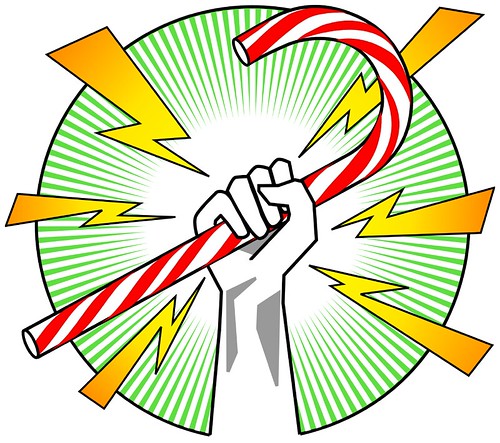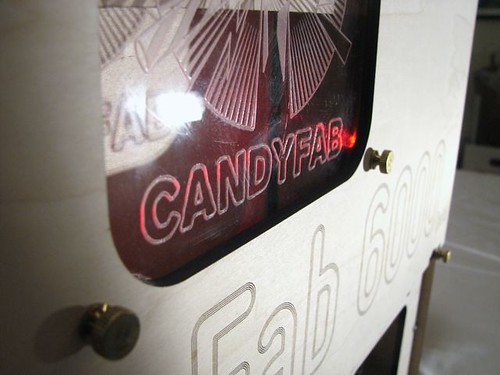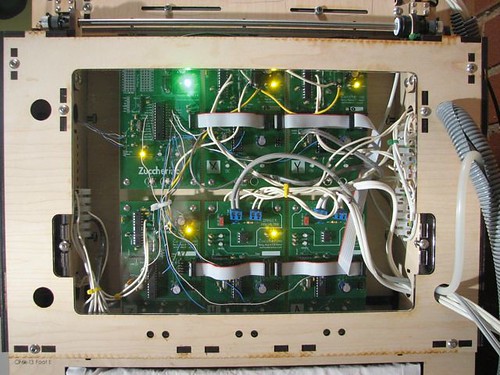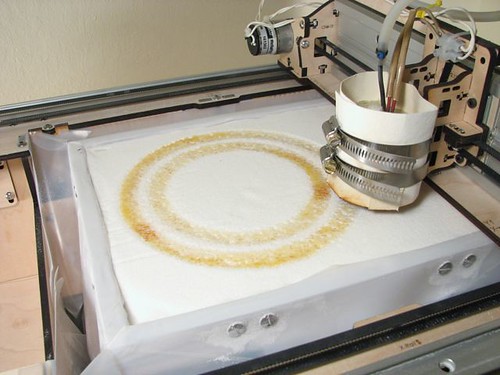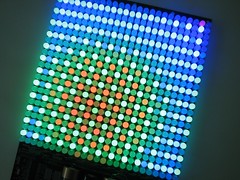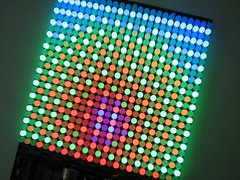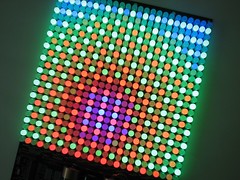- This C-17 is actually quite impressive.
- DIY Spider Catcher.
- Warping text to splines.
- 6174 is an interesting number. And so is 1729. In fact, some people claim that there is no such thing as an uninteresting number.
- Rat or mouse?
- Compact Marble Run, made in four hours.
- Math Midway traveling exhibit.
- Big switch lamp.
- Some thoughts on edible lasers.
- Hello Kthulhu.
- Had not heard of Haidinger’s Brush. Have you?
- We want superconducting maglev train sets. Now.
- Cloud wakes and vortices are visible from space. Did you know that an island can shed vortices in its wake?
- Crocodile locomotion.
All posts by Windell Oskay
Making a Frabjous
George W. Hart is a professor at Stony Brook and is one of our favorite artists, making a wide variety of stunning geometric sculptures. On his of his many works that has particularly captivated us for some time is a sculpture called Frabjous.
When we realized that George had posted a template for this sculpture we dropped everything, grabbed the cardboard and hot glue, and raced to build our own.
Continue reading Making a Frabjous
Basics: Serial communication with AVR microcontrollers
One of the distinguishing characteristics of beginner-friendly microcontroller platforms– Arduino, PICAXE, and a few dozen others– is that they neatly wrap up and hide the nuts-and-bolts details of interfacing with the hardware.
Like everything else, it’s a blessing and a curse. The benefits are clear: A new user who has just acquired an Arduino can plug it in, blink an LED, and have a working demonstration of two-way serial communication in just a few minutes.
The drawbacks are a little harder to see. When you just use one line of initialization that calls a “library,” it’s easy to overlook exactly what’s involved: how many lines of code have invisibly been added to your program? What memory structures have been allocated? What interrupts are now going to disrupt program flow and timing? There’s also a portability issue. We often hear from people who got started with Arduino but now want to explore other AVR microcontroller systems, and don’t know how or where to start the migration process.
In what follows we discuss a minimal setup for serial communication with AVR microcontrollers, and give two example implementations, on an ATmega168 and on an ATtiny2313. While this fundamental “AVR 101” stuff, we’re approaching the problem (this time) from the migration standpoint. Suppose that you had an Arduino based project, where you relied on serial communication– using the library functions–between that hardware and your computer. From there, how would you migrate to a stand-alone AVR microcontroller with similar functionality, or even to a different microcontroller?
Continue reading Basics: Serial communication with AVR microcontrollers
Tiny portable AVR projects: ATtiny2313 breakout boards

We use a lot of our ATmegaXX8 “business card” breakout boards for the ATmega168 microcontroller. We also still wire up a lot of minimal target boards to use the ATtiny2313 microcontroller, so here’s the missing piece: A simple breakout board for the ATtiny2313.
Continue reading Tiny portable AVR projects: ATtiny2313 breakout boards
The CandyFab 6000
Today we are relaunching the CandyFab Project with a new logo and a new wiki site, wiki.candyfab.org.
But more importantly, we are unveiling this new machine, the CandyFab 6000:
It’s a brand new CandyFab– still in beta. A clean break, designed from the ground up with almost no parts in common with the original, the CandyFab 4000. All new mechanics. All new electronics. All new software. Smaller but still big: the build volume is more than 10 liters, but it’s now small enough to fit on a desk top.
Here’s one of the first objects that we fabbed on the CandyFab 6000: a drilled sphere, about two inches in diameter and layer thickness of 1/15 inch. There’s plenty of room for improvement, and finally we have a machine that can be improved.
The machine is designed so that it can be made from scratch– i.e., without dumpster diving for old HP pen plotters. Three axes of quadrature-encoded DC servo motor control. Timing belts and acme lead screws. Food-safe sugar containment. The body is made from laser-cut plywood with acrylic highlights and stainless steel hardware. (Steampunk-compliant brass thumbscrews where appropriate, too.)
The new modular electronics control platform is called Zuccherino— that’s italian for “Sugar cube.” One Arduino-compatible circuit board per axis. (Our prototype above shows X,Y,Z, Heat, and Air axes, plus a master board.)
It’s an expandable system for all kinds of motion control projects, and we’ll be making kit versions of all of the Zuccherino boards later this summer.
We’ve also got new cross platform control software — called CandyFabulous underway, and it’s looking sweet.
And… oh can it fab sugar. In the photo here we’re partway through printing an hollow torus eight inches in diameter.
Where from here? Check out more details at CandyFab Project.
Finally, you can see the CandyFab 6000 first hand– this weekend at Maker Faire! We’ll be showing it off at booth #293, in the Expo Hall.
Linkdump: May 2009
- Hacker emblem
- Alien Autopsy
- I wanna banana lathe!
- marble elevators from the Exploratorium
- Cool Haus (via)
- The Best Comments
- Cute felt sting rays
- Windmill-charged toy car
- Frivolous Theorem of Arithmetic
- MISO, a free font.
- Overly simple balloon animals
- 3B printing?
- Chipmunks versus Star Wars
- Plushes by SukiSuki (Coming soon, but cool looking)
- Sumopaint: An in-browser graphics app.
- VHS Pinball
- Lego Photography Tutorial in Lego, no less.
- Yet another cat that hasn’t quite figured out what to do with the sewing machine.
Peggy 2 RGB

We filled up a Peggy 2 with 2×2 super-pixels consisting of red, green, blue, and white 10 mm LEDs. This makes an easy and big programmable full-color LED matrix.
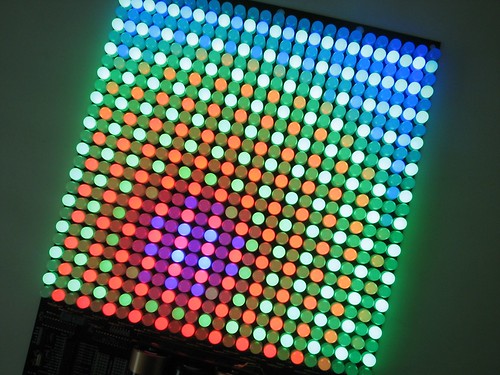
Peggy fits 25×25 LEDs, so if you fill every hole this way, you wind up with a 12.5 x 12.5 pixel RGBW matrix.
And like whoa— you can animate it.
Yup, there’s video. The video is embedded below, and you can also view it directly at YouTube. (In either case, please excuse the scanline artifacts produced by our camera.)
One thing worth noting (and that we demo in the video) is that you can diffuse the big RGBW pixels into one continuous full-color display by placing a thin diffusing plastic layer above the LEDs– it really works well.
The demo code is an Arduino sketch, based on Jay Clegg’s timer-interrupt style grayscale driver for Peggy (demonstrated here), you can download it here (12 kB Arduino .pde sketch file). Besides the colorful flow shown in the pictures, this code also has a mode to light just the red, green, blue or white LEDs at a time.
17 cool magnet tricks
Here are seventeen of our favorite magnet tricks, projects and demos.
Extract batteries from stubborn holders
We’ve all got things that take batteries. Some of them are well designed, and some of them are not. The worst offenders are electronic toys that take (say) half a dozen AA batteries, all of which must be inserted with the correct orientation– spring side first– and pried out, well, somehow. Rather than risk puncturing your batteries by prying them out with something pointy, just use a magnet to lift them out.
Continue reading 17 cool magnet tricks
Evil Mad Kitties on Cheezburger
Neat! Evil Mad Scientist Laboratories cats Harley (left) and JellyBean (right) are making a guest appearance on I Can Has Cheezburger? today.
[These two– the Evil Mad Scientist Laboratories Feline Auxiliary— seem to show up in a lot of our projects. Like here, here, here, here, here, here, here, here, here, here, and here.]
Linkdump: April 2009
- Fail Stickers, of course.
- TTL Emulator (via rrmutt)
- Origins of Life a quirky movie by Raven Hanna and Brandon MacInnis
- Mad Engineers?
- Vintage Suitcase Cat Beds
- Mathematical coincidences at Wikipedia. (Oh, hell yes!)
- Arcade buttons
- Mercury Fountain (via Neatorama)
- Life on earth is still surprising.
- Racing Coasters
- Fontforge: An open source font editor
- Yet another reason for double-blind studies.
- Comic: If TV science were like real science
- Hobby servo to timing belt adapter. Nifty.
- Pouchless tool belt (via Dan’s Data)
- Tweenbots FTW!
- Sin & Cos: The Programmer’s Pals!
- Vector Battle Font by Freaky Fonts






